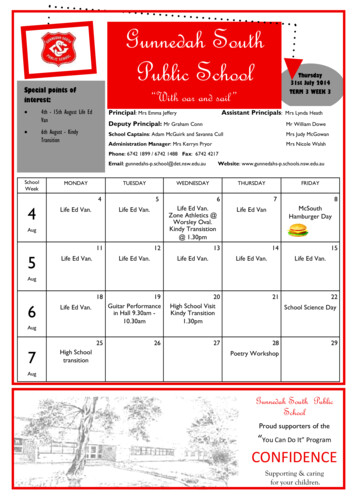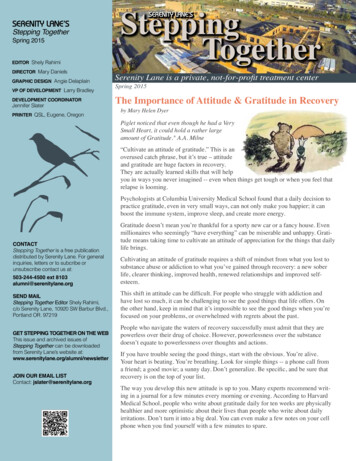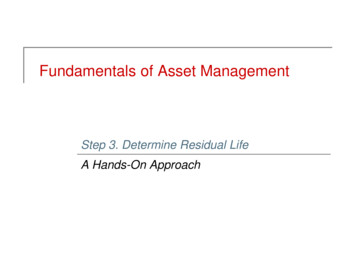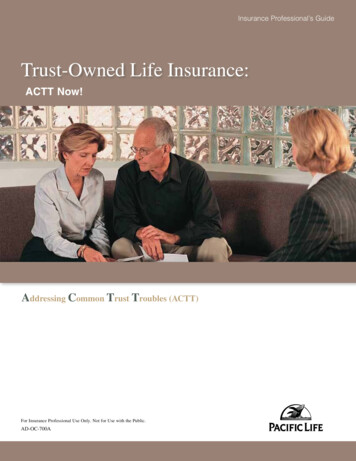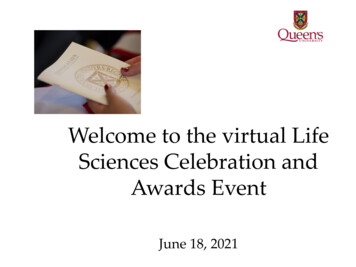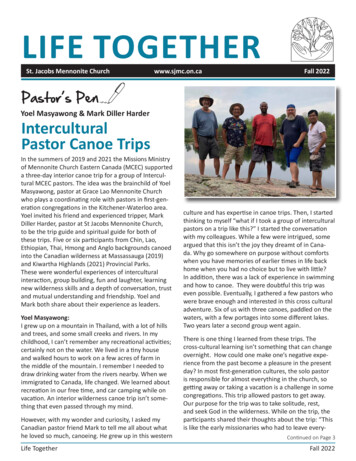
Transcription
LIFE TOGETHERSt. Jacobs Mennonite Churchwww.sjmc.on.caFall 2022Pastor’s PenYoel Masyawong & Mark Diller HarderInterculturalPastor Canoe TripsIn the summers of 2019 and 2021 the Missions Ministryof Mennonite Church Eastern Canada (MCEC) supporteda three-day interior canoe trip for a group of Intercultural MCEC pastors. The idea was the brainchild of YoelMasyawong, pastor at Grace Lao Mennonite Churchwho plays a coordinating role with pastors in first-generation congregations in the Kitchener-Waterloo area.Yoel invited his friend and experienced tripper, MarkDiller Harder, pastor at St Jacobs Mennonite Church,to be the trip guide and spiritual guide for both ofthese trips. Five or six participants from Chin, Lao,Ethiopian, Thai, Hmong and Anglo backgrounds canoedinto the Canadian wilderness at Massassauga (2019)and Kiwartha Highlands (2021) Provincial Parks.These were wonderful experiences of interculturalinteraction, group building, fun and laughter, learningnew wilderness skills and a depth of conversation, trustand mutual understanding and friendship. Yoel andMark both share about their experience as leaders.culture and has expertise in canoe trips. Then, I startedthinking to myself “what if I took a group of interculturalpastors on a trip like this?” I started the conversationwith my colleagues. While a few were intrigued, someargued that this isn’t the joy they dreamt of in Canada. Why go somewhere on purpose without comfortswhen you have memories of earlier times in life backhome when you had no choice but to live with little?In addition, there was a lack of experience in swimmingand how to canoe. They were doubtful this trip waseven possible. Eventually, I gathered a few pastors whowere brave enough and interested in this cross culturaladventure. Six of us with three canoes, paddled on thewaters, with a few portages into some different lakes.Two years later a second group went again.Yoel Masyawong:I grew up on a mountain in Thailand, with a lot of hillsand trees, and some small creeks and rivers. In mychildhood, I can’t remember any recreational activities;certainly not on the water. We lived in a tiny houseand walked hours to work on a few acres of farm inthe middle of the mountain. I remember I needed todraw drinking water from the rivers nearby. When weimmigrated to Canada, life changed. We learned aboutrecreation in our free time, and car camping while onvacation. An interior wilderness canoe trip isn’t something that even passed through my mind.There is one thing I learned from these trips. Thecross-cultural learning isn’t something that can changeovernight. How could one make one’s negative experience from the past become a pleasure in the presentday? In most first-generation cultures, the solo pastoris responsible for almost everything in the church, sogetting away or taking a vacation is a challenge in somecongregations. This trip allowed pastors to get away.Our purpose for the trip was to take solitude, rest,and seek God in the wilderness. While on the trip, theparticipants shared their thoughts about the trip: “Thisis like the early missionaries who had to leave every-However, with my wonder and curiosity, I asked myCanadian pastor friend Mark to tell me all about whathe loved so much, canoeing. He grew up in this westernLife TogetherContinued on Page 31Fall 2022
Writers &ContributorsEditorialBeginnings & EndingsThis issue marks a few endings and acknowledgements of jobs well done.I interviewed some of the men who have maintained our cemetery formany years. Thank you, Ken Bauman and Earl Martin, for your past serviceand Guenther Mohr for your continued service. Pastor Mark, Charles Krugerand Laverne Brubacher share some thoughts on Laverne’s retirement fromregular song leading at SJMC. Thank you, Laverne!We also have a number of beginnings this fall at SJMC. We kicked off thenew church year with a Welcome Back breakfast and saw a larger congregation worshipping in person. We continue our live streaming so that manyothers can join us online for Sunday morning worship and funeral services.Brent Horst EditorIn this issue I highlight the Henry and Edna Shantz family in the crosswordfeature. Hopefully some of you completed last issue’s Brubacher familycrossword. Can you do these without looking at your church directory?I shared one of my writings in worship this summer (see the worship servicefrom August 14, 2022 on www.sjmc.on.ca) and I received comments of appreciation. I have decided to share another Word Picture (1,000 words) relatedto breath. At beginnings, or endings and all times in between, it’s importantto breathe.Yoel Masywong &Mark Diller HarderPastors Mark Diller Harder and Yoel Masyawong from Grace Lao Mennonitewere asked by the Mennonite magazine The Leader to share about theirintercultural canoe trips over the last couple of years. This article is ourPastor’s Pen for this issue.I hope you had a relaxing summer and that you will participate in personand online as you are able. As Mark noted that song leading has evolved atSJMC, so have many other parts of our worship and community life. Thereare many opportunities to participate in various ways, so please feelwelcome to join in our Life Together, as it continues to evolve.BrentThank You!Ken Bauman Article and Picture Contributors St. Jacobs Printery Marilyn Wideman - Life and Times Layout Pauline Martin - ife Together2Fall 2022
Intercultural Pastor Canoe TripsContinuedthing behind to rough it,” or “The lake in our culture isa curse” or “My congregants called me while I was onthe water and it was hard to totally get away.” We didhappen to have data on our phones so some sharedup-to-date photos on Facebook or livestreamed the tripto their congregation or even to Myanmar. One congregational member wanted to know the address of wherewe were. One pastor accidently called 911 and we hadto report that we were just fine.When people enter a new culture, they hold memories and experiences from their past. There are goodmemories, but also wounds and trauma that still canhaunt them. This can make an impact on their currentphysical, spiritual and emotional health. The canoe triphelped open up those places to healing and renewal. Itis not necessary to forget our past but to keep lookingforward. As Paul urges the people in Philippians, “forgetting what lies behind and straining forward to whatlies ahead, I press on toward the goal for the prize ofthe heavenly call of God in Christ Jesus. (Ph.3:13-14) Tocross the cultures, it is not as simple as taking off yourown shoes and putting on new shoes. We may need toleave our socks on, our own identity. The new shoesmay not fit, they may irritate us at the beginning, butwe slowly re-shape the shoes to fit us with our ownintegrity. We need the willingness to learn and adaptthat will bring us to the next level. We experienced thisthrough the joy, peace and beauty of God’s creation inthe Canadian wilderness.Intercultural understanding grows when relationshipsdeepen and become mutual. I do not fish, but severalpastors brought along their fishing gear and took thelead. They threw the full un-scaled fish, head and all,onto the hot coals and soon we were all enjoying itsyummy delights. While swimming in some deep watersoff a rock island, a pastor shared the sharp memory ofswimming for safety across a huge river as an escapingrefugee earlier in life. I would never have been trustedwith that story without first having canoed with him.We prayed and studied the Bible together, the Scriptures coming alive in fresh ways with new perspectives.We could talk about how different our cultural approaches were to preaching and pastoral care and eventheology, and yet we were bound together as trustedChristian pastors. I am reminded of the words of Paul inRomans 1:12 – ‘so that we may be mutually encouragedby each other’s faith, both yours and mine.’ We left thetrip as colleagues and friends, grateful for the gifts wecould share.Mark Diller Harder:When Yoel first approached me to lead these canoetrips, I wondered how it was all going to work. The pastors had never canoed before, let alone been in a wilderness setting where you have to survive off what can becarried with you in your canoes. Two weeks beforehandwe did some canoe training at a local Conservation Areaand that gave me hope. We ventured out. One pastorwas so scared of the water that he didn’t lift a paddleuntil after the first portage. We battled mid-June mosquitoes and cold nights. My more Western style dehydrated food and especially the Minute Rice did not goover well (we changed the menu the second year andYoel made the rice). But soon everyone was comfortableand began to enjoy this new setting. Trust grows whenyou paddle a canoe, set up tents, and hang a bear packtogether, relying on each other within the vulnerabilityof the wilderness. We swam and laughed and played. Wesat around the campfire, watched the stars, marvelled atthe full moon and began to share stories of ministry.Life Together3Fall 2022
Orvie MartinPauline MartinMarcy (Marcella)NinomiyaRetired from internationalinclusive development withpersons with disabilities;currently helping to supporta Syrian refugee family;sharing my recentlypublished memoir.Church OfficeAdministrator atSJMCRetired dairy farmerand now driving peopleto appointmentsChildhood Home: Farm in WoolwichTownship, just outside of St. JacobsPresent Home: St. Jacobs, OntarioChildhood Home: RR1 Drayton, OntarioPresent Home: Elmira, OntarioAge: 59 (turning 60 on October 24)Childhood Home: Conestogo, OntarioPresent Home: St. Jacobs, OntarioAge: 79 Surname: WeberSome of my favourite smells, sounds, tastes: Fresh cut grass 100 horsepower tractorworking at full throttle AERO chocolate bar Fresh-washed kitchen floor River runningover stones Beef roast and mashed potatoes Coffee brewing Popcorn popping Apple Cinnamon Crisp Geese in flight Train whistle Rooster crowing Scent of sandalwood Curry Guitar music Children’s laughter Fresh cut grass Freshly baked breadSome things you may not know about me: Milked cows for 30 years Driving Old Order Mennonites toappointments School bus driver for Ayr Coach Lines Operated a trenching machine for 8 years Was Old Order Mennonite until age of 4 Took ballroom dance lessons Hopped on a train at 18 and went to Albertaand worked for a year Established 4 bakeries for intellectuallychallenged persons: 1 in Japan, 2 inThailand, 1 in Myanmar In Gr. 12, got 3rd prize in national cherrypie contest Speak Vietnamese, Japaneseand Thai languages Gave an injection to a water buffaloPersonality traits others would say I have: Friendly Kind Gentle Considerate Optimistic Like to meet people andstart a conversation Friendly Organized Helpful Optimistic Walking the Health Valley Trail Listening tothe sounds of Nature Watching Blue Jaysbaseball games Identifying trees and birds Playing Crokinole Bowling Camping Road trips History (novels, documentaries, etc) Cooking Listening to great music, all genres Adventurous Inclusive Hard working Grateful Love to laugh CommittedMy interests include: Traveling: learning about other cultures Volunteering for refugees Baking Reading Socializing Jigsaw puzzlesSome favourite lifetime memories: Swimming in the Conestoga River in thesummer Plowing with a 4-horse and 2-bottom plow Skating on the Conestoga River in winter Camping trips with our children, especiallyout East and out West Getting Married Children’s weddings Time spent with grandchildren Life on a turkey farm Nursing in Vietnam Camp nurse in Japan Wedding and marriage life in Tokyo Living in the Okanagan Valley, B.C. Empowering persons with autism,intellectual disabilitiesOther vocations I might have chosen or would choose: Am enjoying my retirement years Teacher or Entrepreneur (Restaurant) Grandparenting Continue friendship with refugee familiesWhere I like to play or ponder: Walking the Health Valley Trail Quiet times in my apartment Reading and meditating Early mornings on the front porch Hiking in the bush By water In the kitchen At the riverside On the deckSome items on my “bucket list”: Travel to the United Kingdom Hang gliding Drive a 6-horse teamLife TogetherLife Together Travel to Newfoundland Road trip across the USA Travel to Europe Travel to the Holy Land (do you catch thetheme here?)4 Drive out west/to USA to visit formercoworkers Share my published memoir Visit Asia again Enjoy grandchildrenWinter 2022Fall 2022
Caring forSacredGroundBrent HorstWhen we are walking the grounds of a cemetery, weusually have a lot on our minds and even more on ourhearts. We might be visiting a grave of a loved onewho passed many years or even centuries before us.We might be attending the funeral of a member of ourfamily or of a friend’s family. Or perhaps we are releasing our soulmate to their final resting place.This might be an over-romanticized description of ourSJMC cemetery but there’s no getting around the factthat cemeteries are important places for many reasons, perhaps even sacred ground. The SJMC cemeteryholds the memories of hundreds of lives. There aremarkers of generations of families and many peoplehave walked the paths over the years.Which brings me to something that may never havecrossed your mind. Who looks after the cemetery?Who mows the lawn? Who trims the grass? Whoprepares the graves? Who does all the “behind thescenes” work?Two of those who have maintained our cemetery areKen Bauman and Earl Martin. They have both helpedkeep it well maintained and presentable for almosttwo decades. They mowed the lawn, trimmed thegrass, and helped with burials. Thank you both foryour long, dedicated service to your church familyand to the families of all those who have used theSJMC cemetery.Guenther Mohr shared some interesting facts aboutthe cemetery and the work that he, Ken and Earl havedone for years.See Ken’s Cemetery Musings for his experiences whilemaintaining our cemetery. Earl had similar memoriesover his 17-18 years. Earl is glad he helped with cemetery maintenance and was glad for the “good workouts in the fresh air” over the years. Earl helped withmany burials over the years. He encourages others toconsider helping if you are able and willing.Life TogetherGuenther started with lawn mowing after his retirement in 2008, usually every two weeks or as needed.He “graduated” to helping with funerals when LukeBrubacher was cemetery overseer. Ivan Brubacher,Amsey Frey, Maynard Bauman and Bruce Brubacherwere past overseers. Oscar Weber, Floyd Martin and5Fall 2022
other volunteers helped with burials and lawn mowingover the years as well. Guenther took over as cemeteryoverseer in 2008 when Luke decided to focus on othercommitments. Guenther looks after burials andcemetery maintenance. He contacts the peopleneeded which includes opening a grave with a backhoe and closing it with a tractor. For a cremation afew of them dig a small hole by hand and close itafter the family leaves. Guenther does any necessaryrecord keeping and sends an email with a spreadsheetto the church for any expenses that need to be paid.The maintenance work is paid at minimum hourlywage and time for burials is part of the funeralexpenses paid by the families. T here has been a tendency to select cremation asa final option. As a result, we have established acremation only section in the north-east part of thecemetery. Plots will be large enough (2’x2’) for an urnand a flat plaque marker. This is a lower cost alternative to purchasing a full lot for cremated remains.The option for interment of cremated remains on topof an existing family gravesite is also an option manypeople have chosen.Guenther needs help with funerals and lawn mowing and trimming now that Ken and Earl are taking awell-deserved break from their work. Lawn maintenance includes mowing down the rows with a ridingmower and around the gravestones with gas pushmowers. Some maintenance around stones with aweed-eater is necessary at times. Full burials requirepreparing the site and cleaning up after interment. Forpreparing we measure the site and lay down sheetsof plywood to minimize damage to sod. The cleanupprocess includes dumping dirt back into the grave, removing any leftover dirt, removing the plywood sheetsand putting back sod. Interment of cremations requirepreparing the site by hand digging a 2’ by 2’ by 2’ holeand cleaning up after interment. Prices were recently adjusted to reflect current costsand government changes. Anyone who is interestedin knowing what they are should contact Guenther. SJMC owns more land, but the cemetery expansionis still outstanding.So, who will help Guenther keep the cemetery in goodshape and make sure burials are looked after properly? If you feel a call to help, talk to Guenther or toDoug Shantz, Finance and Facilities Ministry Leader.Trevor Bauman has started to help with maintenancebut we could use one or two other regular maintenance workers and help with burials.I asked for stories from their work and some of themare best not repeated. Ken shared one in his musingsand Guenther shared this one from a full burial.“The ground in the cemetery varies from solid to graveland sand. This time it was more gravel and sand. Thevault was inserted in the grave. We had gone forlunch and expected to come back later to oversee thefuneral. However, the grave caved in while we weregone. Fortunately, Luke had come by and checkedthe grave. He had to jump into the grave and removethe dirt that had partially filled the vault. The familywas at the grave site shortly after. An embarrassmentavoided.”Some other facts Guenther shared: Number of full size plots: 766 (including the old part)Ken Bauman W ith available (155) and reserved plots (64 but nolonger allowed), we would be full at 219.Life TogetherEarl MartinThanks again to Ken and Earl for your past service andto Guenther for your continued service.6Fall 2022
Cemetery Maintenance MusingsKen BaumanIn the spring of 2004, when I was 66, I changed from full time to part time at HomeHardware Stores which I did until age 80. This was the time that I started with SJMCcemetery maintenance and worked at that until the end of the 2021 season. After18 years, I “retired” from this work at age 83.Most of my time over all those years was spent mowing grass around the tombstones and under low trees, along fences and the east side of the Three BridgesRoad; anyplace where the riding mower can’t do the job. This was usually doneevery other week and sometimes more frequently depending on the weather.When the grass gets too long the riding mover leaves a little too much loose grass,so I go over that again to make things look tidier.In the first nine years, there were three or four people helping with cemeterymaintenance, so I worked about 18 to 20 hours a year. After 2012 the hours havesteadily increased, amounting to over 50 hours in 2021 when the team was downto me, Earl Martin, and Guenther Mohr. I think I did over 450 hours over the eighteen years. I did very little grass trimming and tree trimming. I did get to paint thecemetery sign once.I never did mow grass with the riding mower, and I was happy not to have to dothat. When I started, Maynard Bauman was in charge and when he left OscarWeber took over. When I started, Nelson Weber brought his riding lawnmowerfrom Conestogo to the cemetery. When he stopped, Floyd Martin brought hisriding mower to cut the grass and we are still using his mower today. The door tothe cemetery shed was made bigger so the lawnmower could be kept at thecemetery and used as long as it would last. It’s still going! When Floyd stoppedworking at the cemetery Guenther Mohr took over organizing the maintenancecrew. Guenther is also the current cemetery overseer.I only helped with the opening and closing of the graves a few times. That wasn’tpaid an hourly rate but part of the funeral expenses and passed on by the funeralhome. I recall being there for the closing of Milo Shantz’s grave and many of hisfamily took their turn to put in a shovelful of dirt.The work that I did at the cemetery was never something that I liked or disliked, butrather a job that needed to be done. I must have enjoyed the work enough to keepdoing it for eighteen years.When I worked alone at the cemetery, I always took water along but this day Iforgot, and it was a huge mistake. After cutting grass for over an hour on a hotsummer day I knew I was in trouble without any water to drink. I decided that Ineeded to drive back to Elmira to get some water. Before I had time to return thelawn mower to the shed, I noticed Margaret Metzger walking towards me carryinga flowering hanging planter. I was cutting grass close to Peter’s stone, and I guessedshe had flowers for her husband’ grave. I shut off the mower and stopped to talkwith her. She wondered if I had anything to cut the hanger off the planter, but I wasable to release the planter hangers easily to remove them. I am sure the flowerswere lovely but what caught my eye was the container of clean clear water that shehad brought with her. When I told her of the predicament I was in and askedif I could have a drink of water, she was more than happy to oblige. I was verythankful. Looking back now a drink of water is a small thing but at the time it wasno small thing and I never forgot it.Life Together7Fall 2022
A well-deservedBrent HorstOn August 28, Laverne Brubacher took his last regular turn as oneof our song leaders at SJMC. Pastor Mark acknowledged this witha heartfelt message of gratitude:“Laverne is retiring from being on the regular Sunday morningsong leading roster after 63 years! I think that is an amazing run!Laverne, you started song leading when you were 15 with initialencouragement as a Rockway Mennonite Collegiate student in thatsetting, but soon with the trust and encouragement of the wise leadersof the time from SJMC, your home congregation. We still have that spiritof giving young people opportunities to test and grow their gifts. For manyof those years, you were the only or prime song leader - and you havehelped mentor others who have joined the roster.Song leading has changed and shifted over the years. It used to be very simple Richard Yordy would leave all the hymn slots blank and you would choose all the hymns,leaving the hymn of response blank until hearing the sermon. As time went on, first pastors,and then the combination of pastors and worship leaders did more shaping of worship andthemes. They would carefully choose the hymns and pass them on to all of you as song leaders,knowing they would be well led. They used to be pretty well all four-part a cappella, somethingwe still enjoy, but now there is a broad range of musical styles and genres and the complexityand beauty that brings. I wonder how many different hymnals you have led from; Church andSS hymnal, the black, rust, blue and now purple Mennonite hymnals, Life Songs 1 and 2, Singand Rejoice, Sing the Journey and Sing the Story. You have led them all well and shaped somuch of the character of our good congregational singing. You have left a legacy. And I knowhow much you have enjoyed it and been fed yourself by the experience. When we met thisweek, you said you got more out of song leading than you have given. It is part of your wholephilosophy of life of giving back. Song leading has been a deep part of your spiritual journey,and for that we give thanks.We chose to give you a pottery bowl from Phil Yordy. It is a very down to earth bowl, a simplebowl, and yet elegant and beautiful. The colours mix together to form a beautiful whole, like themany varied voices in a congregation. A bowl is a container, a holder of many things, a symbol.This bowl holds our gratitude, our many good memories of you standing up, giving us the hymnnumber, blowing your pitch pipe and leading us in vigorous and spirited singing. This bowl holdsthe many songs and hymns sung by this congregation over the years in our worship to God. Thisbowl holds our musical offerings to the audience of One. May it be a reminder to you of the giftand opportunity to lead the songs of the church. Thank you, Laverne!” (Mark Diller Harder)For a more complete record of Laverne’s amazing contribution to the musical life of ourcongregation, please see the article by Charles Kruger in the February 2009 edition ofLife Together. That was to recognize Laverne’s 50-year milestone in leading singingand thankfully he continued for 13 more years! A few excerpts from that article:“Some early memories of Laverne’s early music making include singing with his family,“The Lord is in His Holy Temple” at the beginning of Sunday School and opening eachsession of Summer Bible School with “Marching to Zion”. Laverne had his debut inmusical leadership at a Sunday evening service at the tender age of 15 .Asked forsome of the highlights of Laverne’s musical involvement at SJMC he mentionedLife Together8Fall 2022
impromptu singing at the Life Songs Singersconcert in the St. Jacobs Schoolhouse Theatre,leading singing at Marcia’s and Larry’s wedding, thecathedral-like sound of SJMC’s annual silo singing,and singing the part of Balthazar in “Amahl and theNight Visitors”, an SJMC musical production in 1995.Laverne has felt privileged to lead singing at funeralsand considers Easter Sunday a highlight each year .Laverne’s respect for the contributions of our manytalented musicians to our church’s musical worshipwas an emphasis in his overall comments on thestate of music in our church .His music leadershiphas challenged him to do what he sometimes thought he couldn’t do, and has helped him become more confidentin public forums. Church music is and has been an important part of Laverne’s life.” (Charles Kruger)Crossword1These last words come from Laverne’s current thoughts on his retirement from the regular song leader roster.235“In the last thirteen years, the role of the song leader has continued to evolve. We have the pianistgiving the first8chord of the hymn, instead of using a pitch pipe. Many of the hymns are now accompanied. The new Voices Together has lots of new songs for us to learn, while keeping many of the older favourites. The last two and a halfyears dealing with Covid has kept us from meeting together and that has affected our ability to sing11together. I12look forward to singing in a full house again. I am very pleased to see a number of very good younger song leadersstepping up. We are indeed a very musical congregation. I’m grateful to be a part of a congregation 14who encourages people to develop and to grow. I very much appreciate the opportunity that I was given.Thank you.” (Laverne16Brubacher)17Crossword Puzzle1234will continueto enjoyhearing your voice18amongThank you, Laverne for your long musical service at SJMC and we567us in many ways for many years to come.819Crossword PuzzleBrubacherFamily CROSSWORD PUZZLE91112ANSWERS20101314Down:161SA8M O H RA11A S H 12LO14C O U R16E M M AIR18OSLU19J A Y N ENLife Together23417BRH56 18 7R A Y M O N DJ I MSUAR199CNS A N 10D R AOAE YT13CNC15MT N Down:E Y1.oldest daughter ofA youngest sonNr2.middle sonSorry fo o17the typ r!R of GoldestT H of EdaughtersonG U 3. N husbanduenthe4.matriarch's maiden nameKH grandson attending7.greatSJMC10. oldest sonI12. married granddaughter SJMC member2013.C wifeA ofRyoungestR son14.15.18.oldest daughteryoungest sonwife of middle son91.2.3.4.7.15oldest daughter of youngest sonmiddle sonhusband of daughter of oldest sonmatriarch's maiden namegreat grandson attending SJMC10.oldest son13.14.15.wife of youngest sonoldest daughteryoungest son20 12.18.married granddaughter SJMC memberAc5.6.8.9.111416171920wife of middle sonAcross:5.patriarch's first name8.married name of youngest daughter6.9.11.14.husband of oldest daughteryoungest daughteryoungest daughter of youngest sonmiddle daughter of youngest son 16.17.19.20.matriarch's first nameBuilhusband's name of youngest daughterwife of oldest sonmarried name of oldest daughterFall 2022
A Billion BreathsI breathe; therefore I am. Take a deep breath. Breathe it out.Breathe easy. We take a breath twelve to twenty times every minute of every day. That’s up to 28,000 breaths a day!Most breaths we don’t even notice. Some are unforgettable.We catch our breath, we sigh, we blow out candles, we blowsweet nothings into a loved one’s ear, or we huff and puffand try to blow the house down! We inhale, exhale, respire,pant, gasp, and wheeze.breath when I emerged from the water was memorable. Wesay we need a breath of fresh air, sometimes figuratively butsometimes physically if we feel suffocated in some way. Ifsomeone does restrict our breathing for whatever reason,it’s frightening, and we fight to take that next breath.When we meditate or try to calm ourselves, we breathedeeply, rhythmically, and very consciously. “Take a deepbreath. In and out. In and out. As you breathe in, breathein the energy of those around you, feel your lungs fill withoxygen, notice your chest expand. Now breathe out, slowlyand with control. As you breathe out, relax your chest,relax your body, breathe out all the stresses and worries ofyour mind. Breathe in, breathe out and relax.” Breathingis integral to many things we do in life and controlling it,sensing it, and using it most efficiently can be very important in many things. So much of vocal performance, playingwind instruments, having a baby, enduring pain or being anathlete is about breath control.Sometimes we are out of breath. We get on the treadmilleach January, intending on fulfilling that annual New Year’sresolution to exercise. Soon we feel out of breath, our heartpumps hard trying to get enough oxygen to our muscles,and we think we’re going to die! I’ve run ten minutes now- am I skinny yet? Marathon runners manage their breathing
to their congregation or even to Myanmar. One congre-gational member wanted to know the address of where we were. One pastor accidently called 911 and we had to report that we were just fine. When people enter a new culture, they hold memo-ries and experiences from their past. There are good memories, but also wounds and trauma that still can

